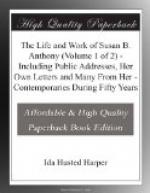In the ten weeks before the State convention at Albany, 6,000 names were secured for the petition that married women should be entitled to the wages they earned and to the equal guardianship of their children, and 4,000 asking for the suffrage. Miss Anthony herself trudged from house to house during that stormy winter, many of the women slamming the door in her face with the statement that they “had all the rights they wanted;” although at this time an employer was bound by law to pay the wife’s wages to the husband, and the father had the power to apprentice young children without the mother’s consent, and even to dispose of them by will at his death. One minister, in Rochester, after looking her over carefully, said: “Miss Anthony, you are too fine a physical specimen of woman to be doing such work as this. You ought to marry and have children.” Ignoring the insult, she replied in a dignified manner: “I think it a much wiser thing to secure for the thousands of mothers in this State the legal control of the children they now have, than to bring others into the world who would not belong to me after they were born.”
The State convention met in Association Hall, Albany, February 14, 1854. Elizabeth Cady Stanton, president, delivered a magnificent address which Miss Anthony had printed and laid upon the desk of every member of the Legislature; she also circulated 50,000 of these pamphlets throughout the State. The convention had been called for two days, but so great was the interest aroused and so popular were the speakers in attendance that evening meetings were held for two weeks; the questions under consideration were taken up by the newspapers of Albany and the discussion spread through the press of the State, finding able defenders as well as bitter opponents. A peculiar illustration of the uncertain disposition of an audience was here given. While in other places women had been prevented from speaking, now they would not hear any but women, and whenever Mr. Channing or Mr. May attempted to speak he was at once cried down in a good-natured but effective manner. The women were greatly distressed at this, as these men had been their strongest allies, their leaders, their educators; but their appeals to the audience to listen to masculine eloquence were made in vain.
The petitions with their 10,000 names were presented in the Assembly, and strongly advocated by Mr. Peters, and Mr. D. P. Wood, of Onondaga county, but vehemently opposed by Mr. Burnett, of Essex. In his speech against the petition asking only that married women might possess their own wages and have equal guardianship of their children, he said:




